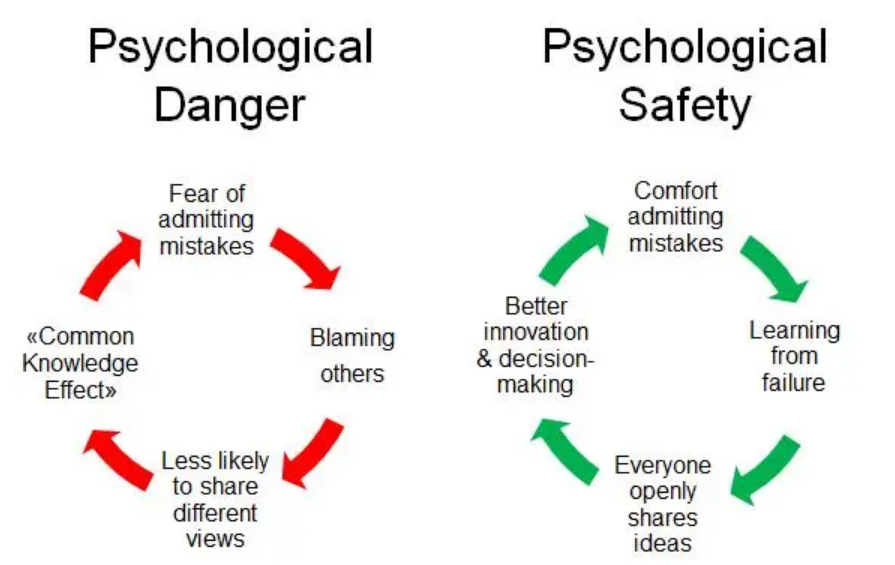By: Robert Avsec, Executive Fire Officer
Recently, I saw this video from the Fire Department Safety Officers Association (FDSOA), one of the latest in their Wellness Wednesday series, come across my LinkedIn feed.

Watch the video: https://youtu.be/9e4-pn8shcQ
What really caught my attention was that of a response to the question, What is the number one hazard facing the fire service today?, from my fire service colleague, Dr. Lindsay Judah, CTO. Her response was “Psychological safety.”
For those who might not be familiar with the term, here’s a definition from the Center for Creative Leadership:
Psychological safety is the belief that you won’t be punished or humiliated for speaking up with ideas, questions, concerns, or mistakes. At work, it’s a shared expectation held by members of a team that teammates will not embarrass, reject, or punish them for sharing ideas, taking risks, or soliciting feedback [1].
Now I knew what Dr. Judah meant when she answered the question because I’m a member of the Fire Service Psychological Association (FSPA) and psychological safety is just one of the many aspects of organizational psychology that could benefit fire service organizations and their members. It’s a topic of frequent discussion amongst me and my colleagues—psychologists and fire service leaders—at FSPA as we work to “bridge the gap between professional psychology and the fire service.” It’s important because psychology has much more to offer to the fire service than just intervention (e.g., working with firefighters and officers who are struggling with mental health issues).
What Psychological Safety Is and Isn’t
Psychological safety in a fire department means working with leaders (e.g., company officers and chief officers) who create an atmosphere of psychological safety by demonstrating through their actions that they truly value and respect truthfulness, candor, and honesty. In typical fire service vernacular, it means knowing that everyone on the team will “have each other’s back.”
Bullying, tunnel vision, relying on “tradition”/status quo as the answer/solution to all questions, culture of racism/misogyny/homophobia all contribute to people’s fear of bringing their true selves to the job and a lack of psychological safety. In the emergency services lack of psychological safety impacts the physical safety of the team and our communities.
Brenda Burkman, Captain (Ret.) FDNY
And that’s not what we should expect when we answer the call to become firefighters, right? I believe so because in our business we need everyone to have their “heads in the game” because we never know what challenges we may encounter the next time the alarm sounds.
Read Next: 7 keys to rebuilding the fire service brotherhood and sisterhood
Psychological safety doesn’t mean that everyone must be congenial to everyone all the time. Rather, it means that everyone in the organization feels safe to express themselves, share feedback, openly challenge “the way things are,” work through tough situations with their teammates, and yes, disagree with people.

“Empowering our people,” is a commonly heard phrase in many organizations today and fire departments are no exception. But if members of the organization feel they will be ridiculed, harassed, or retaliated upon for asking the tough questions, voicing their concerns, asking for help, or taking calculated risks, they’re not likely to feel empowered to do anything but “keep their head down.” And that’s no way for a fire department to operate if it expects to meet today’s challenges and those in the future.
As part of their research study, Loignon and Wormington, surveyed 278 senior business leaders attending the CCL’s program, Leadership at the Peak, between August 2019 and February 2022 and what they found was that teams with high degrees of psychological safety reported higher levels of performance and lower levels of interpersonal conflict [2].
But not all team members will necessarily have the same perspectives on psychological safety and that’s reflected in the results of the research by Loignon and Wormington study where they found that the greatest variance in the perceived levels of psychological safety was in senior management teams where 62-percent of the survey’s respondents felt that psychological safety was lacking.
That should be disconcerting to fire department leaders because how can any organization effectively and efficiently to the challenges it faces when people don’t feel safe to articulate innovative ideas, offer creative solutions to problems, and work teams aren’t collaborating for the benefit of the organization?
Creating Psychological Safety in Your Fire Department
Using the Center for Creative Leadership article as a basis, here are eight steps for creating an atmosphere of psychological safety in your fire department [3].
1. Make Psychological Safety as Important as Fireground Safety
Make the linkage between psychological safety for members and the benefits that can result: more innovation, better team engagement and collaboration, and better inclusion. That last point is particularly important for fire department leaders who truly want to make use of the knowledge and talents that non-majority members (e.g., women, people of color, people of different ethnic backgrounds) bring to the organization.
But don’t just talk about it, model the behavior Ask for help when you need it, and freely give help when asked.
Read Next: ‘Be a not-knower’: The power of leading with humility
2. Make it OK for Everyone to Speak Up
On the fireground, we expect anyone to bring a safety issue to the attention of the incident commander and the fire department workplace (e.g., fire stations and administrative offices) must be no different. As a leader, show genuine curiosity and empathy in the workplace, and honor openness and truthfulness. When someone is brave enough to challenge the status quo, support them by responding with statements like, “Tell me more” or “I’d not consider that yet.”
Read Next: 11 Tips for Talking to Someone You Disagree With
It may not be what you want to hear but your organization needs you to be open-minded, compassionate, and willing to listen. Avoid being so entrenched in your position that you fail to realize “It’s not about me. It’s about making us better.”
3. We May Fail, But We Will Always Try
Professional development of organizations and individuals is a risky business and experimentation and calculate risk-taking are important components for progress. Mistakes are an opportunity for growth and as a leader you must encourage learning from failure and disappointment. Be honest with your people and openly share your hard-won lessons learned from the “school of hard knocks.” Nothing will send a clearer message than your people knowing “Hey, the boss has been there, done that, and has the t-shirt to prove it!”
4. Make “Why not? Your Default Mode
Listen with the desire to understand, not the desire to respond immediately. You only want ideas that have been thoroughly tested? You only want to consider ideas that are low risk and well formulated? Good luck with that. The challenges facing fire departments, including yours, require highly creative, out-of-the-box ideas that may be in their infancy. Be an incubator for those ideas. Sure, ask the tough questions, but do so while always being supportive at the same time.
Read Next: Ideation: Incubation places space between an idea and a decision.
5. Conflict is Good, When Managed Appropriately
Be a champion for sincere dialogue and constructive debate by helping your people to learn how to work together and resolve conflicts productively. Teach your company officers and chief officers how to create team expectations that promote psychological safety by using these questions [4]:
- How will team members communicate their concerns about a process that isn’t working?
- How can reservations be shared with colleagues in a respectful manner?
- What are our norms for managing conflicting perspectives?
6. Evaluate and Revaluate
You don’t just size-up a fire situation once, right? You reassess to ensure that your incident action plan is working, right? Same with your efforts to create psychological safety in your fire department. Don’t just focus on the overall level of psychological safety—Is the “fire” going out?—but look at individual team members and their perceived patterns of psychological safety (Is everyone safely doing their job, and doing it safely, in their assigned area on the “fire scene”?). Stay focused on ensuring that the level of psychological safety is consistent across the organization.
7. Promote Dialogue
Developing everyone’s skill at giving and receiving feedback is critical if you want to have that atmosphere where people know that they can raise concerns. Ask your colleagues and direct reports powerful, open-ended questions, and then listen actively (To understand, not to reply, remember?). Provide opportunities to learn how to share constructive feedback to one another and what respectful responses look like.
8. Promote and Amplify Successes
Pay attention and provide positive feedback! Notice and acknowledge what’s going well. Trust and mutual respect are built when individuals use the tools of positive interactions and conversations. More than ever before, we must learn to promote and amplify successes, large and small because in too many fire departments—especially in the aftermath of the COVID-19 pandemic—firefighters and officers are stretched to the breaking point mentally and physically.
For my money, few people do this better than my colleague, Dr. Reggie Freeman, chief of the Oakland (Calif.) Fire Department. My LinkedIn and Facebook feeds “blow up” regularly with posts from Chief Freeman celebrating the successes of his people for everything from a successful emergency response to a promotion to a retirement of a long-time member of OFD. Learn and teach how to share credit and embrace expertise among many, and the success of the collective, versus a single “hero” mentality.
Using safe practices and promoting the safe management of fire scenes has greatly reduced the number of line-of-duty deaths and injuries. Equally important for fire departments to be successful is creating and maintaining an atmosphere of psychological safety for their members in the non-emergency space (e.g., fire stations, headquarters, training academy). When people feel psychologically safe, anything is possible!
References
1. Center for Creative Leadership. What Is Psychological Safety at Work? How Leaders Can Build Psychologically Safe Workplaces. December 15, 2022. <Available online> https://tinyurl.com/ypvmf8j2
2. Loignon, A. and Wormington, S. Psychologically Safe for Some, but Not All?: The Downsides of Assuming Shared Psychological Safety among Senior Leadership Teams. 2022. p. 8.<Available online> https://tinyurl.com/yckbnm6w
3. Center for Creative Leadership. What Is Psychological Safety at Work? How Leaders Can Build Psychologically Safe Workplaces. December 15, 2022. <Available online> https://tinyurl.com/ypvmf8j2
4. Ibid.
 Fire & EMS Leader Pro The job of old firefighters is to teach young firefighters how to become old firefighters!
Fire & EMS Leader Pro The job of old firefighters is to teach young firefighters how to become old firefighters!

